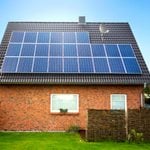What To Know About Community Solar and Net Metering

Rooftop PV panels aren't the only way to take advantage of solar energy.
As clean energy becomes more available and affordable, households across the country are looking for ways to take advantage of it.
The Solar Energy Industries Association (SEIA) estimates more than 13 percent of homes in the U.S. will have a rooftop solar photovoltaic (PV) system by 2030. And some towns—like Babcock Ranch—are turning to solar power completely. But not every roof in the U.S. is suitable for a solar setup. That’s where community solar comes in.
On This Page
What Is Community Solar?
Community solar is a way to share solar energy with other homes in your community. It lets people access the benefits of solar energy even if their homes can’t support PV panels.
Some community solar projects are subscription models owned by a third party or even the utility company, the U.S. Department of Energy says. Others are community-owned. These co-op solar projects allow community members to pool investments to purchase and maintain the project, usually under an LLC.
Community solar isn’t just reserved for states that are warm, dry and sunny year-round. In 2020, Minnesota’s community solar market was larger than any other state’s, according to a report from the National Renewable Energy Laboratory.
Unlike a home rooftop system, which won’t perform well on shaded and snow-covered homes, a community solar garden can be placed in a full sun area, like the plains of Minnesota. The sunny state of California ranks first for overall solar capacity, according to SEIA.
What Is Net Metering?
If you install solar panels on your roof, you can deliver excess energy (solar-generated electricity beyond that powering your home) directly to the electrical grid. The utility then gives you credit — they pay you. That’s called “net metering.”
In some states you can take advantage of solar-power savings without installing solar panels on your roof by joining a community solar garden. It works like this:
Owned by a local “farmer” or a cooperative with acres of solar panels, the garden generates electricity. Rather than powering a home directly, the garden distributes electricity to the local utility provider. Participating community members receive credit on each electricity bill for a share of the power generation.
Members pay a lesser portion back to the solar farmer. The rest is savings, estimated at about 10 percent of your monthly electric bill. This is called “virtual net metering” because the solar power isn’t counted on your actual meter. Not every state allows this, though about 25 states currently do, and the laws and rules are evolving.
The initial investment, by the way, would be $0 for the solar garden in a community. Some solar garden farmers are giving incentives for new members to join. The “locked-in discount” would be one cent per kilowatt-hour, equal to about a 10 percent annual savings.
Ask your utility provider about community solar gardens in your area.
Is Community Solar Right for Me?
Interested in solar energy but not sure about about installing a system or joining a community solar garden? Consider your home’s design and location, how long you intend to stay there, how much you want to invest, and what others in your community are doing.
Community solar could be right for you if:
- You’re a renter without a rooftop to install solar panels.
- The roof of your home is too small for solar panels or doesn’t get south-facing sunshine.
- You just don’t want solar panels on your roof.
- You may relocate in the next year or two.
Your actual savings depend on several factors:
- How much energy the garden produces (weather, solar panel efficiency).
- The rate at which the utility’s prices increase annually.
- The policies of your electric utility and your state.
How to Get Started in Community Solar
To get started in community solar, check for existing projects in your area. In partnership with SEIA and the U.S. Department of Energy, EnergySage provides an easy to use tool to search for community solar projects by zip code. SEIA provides a long list of other resources for those interested in community solar, including a residential consumer guide.



